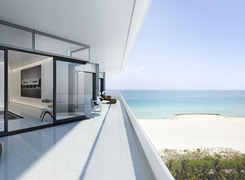Miami Condo Developers See Promise in Foreign Buyers

Miami’s real-estate market has been hot lately, spurred largely by an influx of wealthy foreign buyers purchasing second homes with cash.
The latest data, released Thursday by Douglas Elliman Real Estate, show prices at the luxury end of the market (the top 10% of sales) have jumped significantly from a year ago. The average sales price for these high-end condominiums was $1.57 million in the first quarter of 2013, up 18.5% from the first quarter of 2012. Luxury single-family homes sold for an average of $2.02 million, an increase of 15.4% from the previous year.
Foreign wealth is pouring into Miami and nearby areas, but there’s now a shortage of inventory on the market as a result of the building slowdown during the downturn. “You’re seeing this almost release of pent-up demand into the market even though inventory is contracting,” says Jonathan Miller of Miller Samuel Inc., who prepared the report.
Several very high-end new buildings are currently under construction or soon-to-begin construction—and developers are specifically eyeing the lucrative overseas buyer, asthe Journal wrote today in Mansion. Developers use design and amenities to target buyers from various regions and countries. For South American buyers, contemporary design is a big selling point, as are very large outdoor terraces for entertaining. Secured parking is particularly important to the Brazilian buyer, as many will keep their most expensive cars in the U.S., where security is less of a concern and bullet-proofing isn’t a necessary upgrade.
At Faena House, a coming Miami project by an Argentine developer, apartments will have sprawling terraces they’re calling “aleros,” a Spanish word for balcony. Prices there range from $2.3 million to $50 million.
Mr. Miller says about three-fourths of buyers of condos are purchasing with cash. He says the double-digit price increase isn’t being skewed by the higher-end sales or larger homes and condos, as average square-footage has remained flat. But average prices are still off by almost 37% from their peak, in the second quarter of 2007, before the credit crunch and housing-market crash. “That peak was artificial,” he says.
Source: http://blogs.wsj.com




in Social Networks